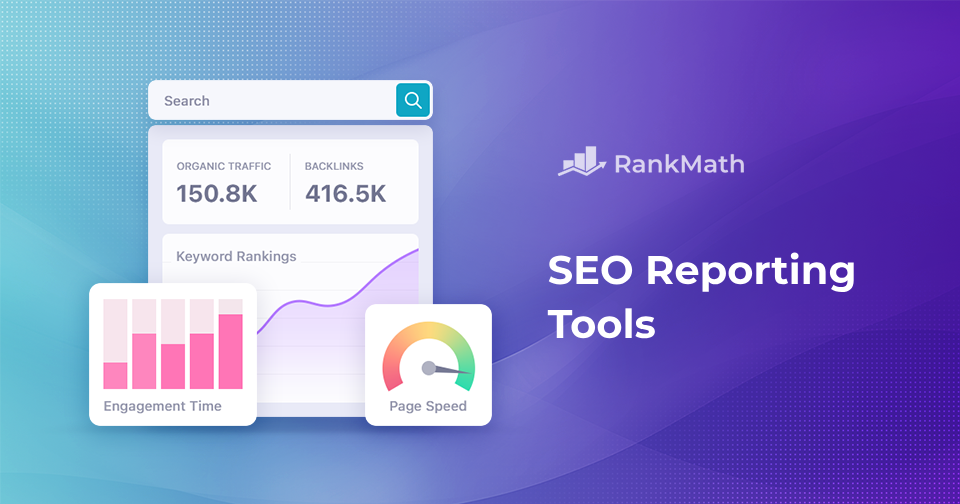SEO reporting involves tracking, analyzing, and reporting on various metrics related to a website’s search engine optimization (SEO) performance.
This includes monitoring key indicators such as website traffic, keyword rankings, backlinks, and overall visibility on search engine results pages (SERPs).
Fortunately, many SEO reporting tools help you gain valuable insights into the effectiveness of your SEO strategies, identify areas for improvement, and make data-driven decisions to enhance your online presence.
In this post, we’ll discuss the free SEO reporting tools, providing an overview of their features and tips for effective utilization.
Table Of Contents
Free SEO Reporting Tools
Let us now discuss the free SEO reporting tools.
1 Google Analytics
Google Analytics is a powerful web analytics tool provided by Google that allows you to track and analyze various aspects of the website’s performance.
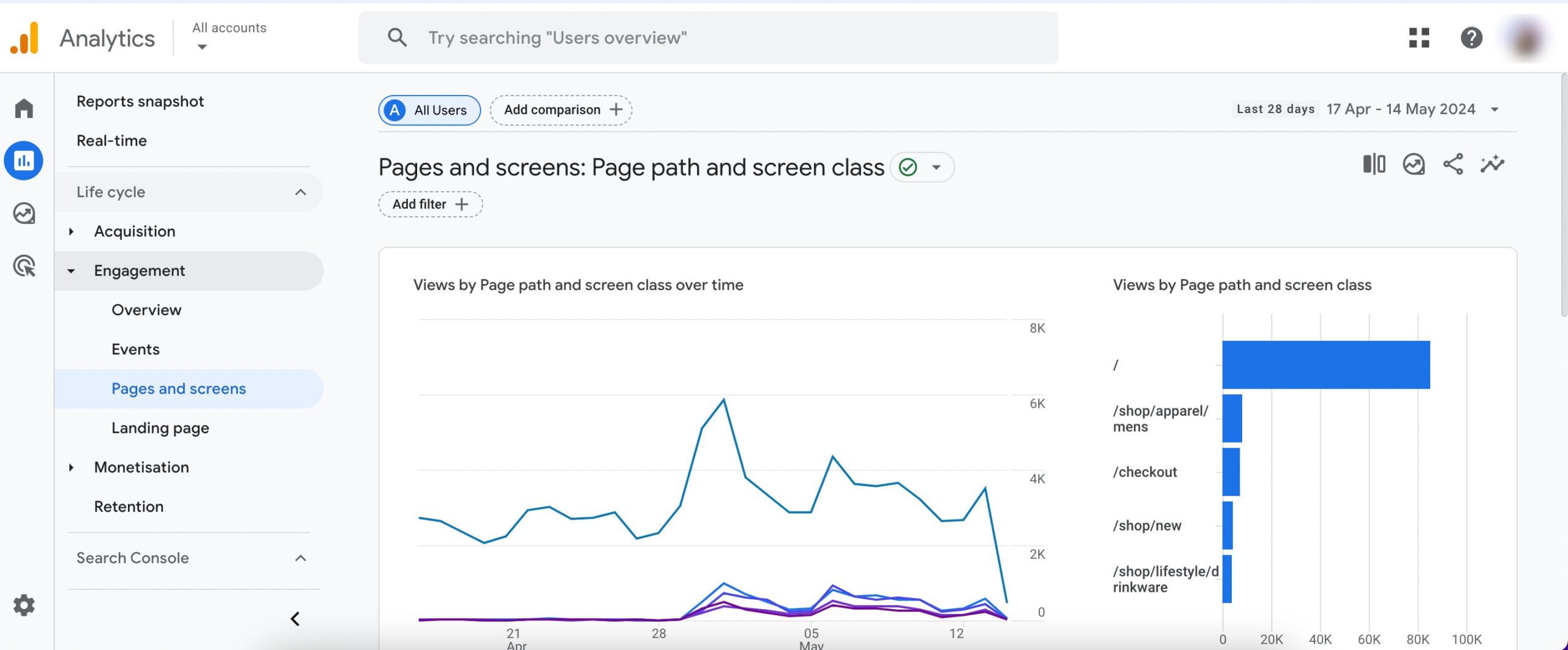
Setting up Google Analytics involves creating an account, adding the tracking code to the website, and configuring goals and filters as needed.
Refer to our dedicated tutorial on installing Google Analytics with Rank Math.
Overview of Features
Google Analytics offers a wide range of features to monitor and analyze website data. Some of its key features include:
- Audience: Provides insights into website visitors’ demographics, interests, and behavior.
- Acquisition: Shows how visitors are finding the website, including organic search, direct traffic, referrals, and social media.
- Engagement: Analyzes how visitors interact with the website, including page views, bounce rates, and site speed.
- Conversions: Tracks goal completions, e-commerce transactions, and other conversion metrics.
- Real-Time: Allows real-time website traffic monitoring, including active users, page views, and traffic sources.
Tips for Optimizing SEO Using Google Analytics
Track organic search traffic and keywords to identify opportunities for optimization. Analyze user behavior and engagement metrics to improve website usability and content relevance.
Google Analytics helps monitor conversion rates and set up goals to track the effectiveness of SEO efforts in driving desired actions.
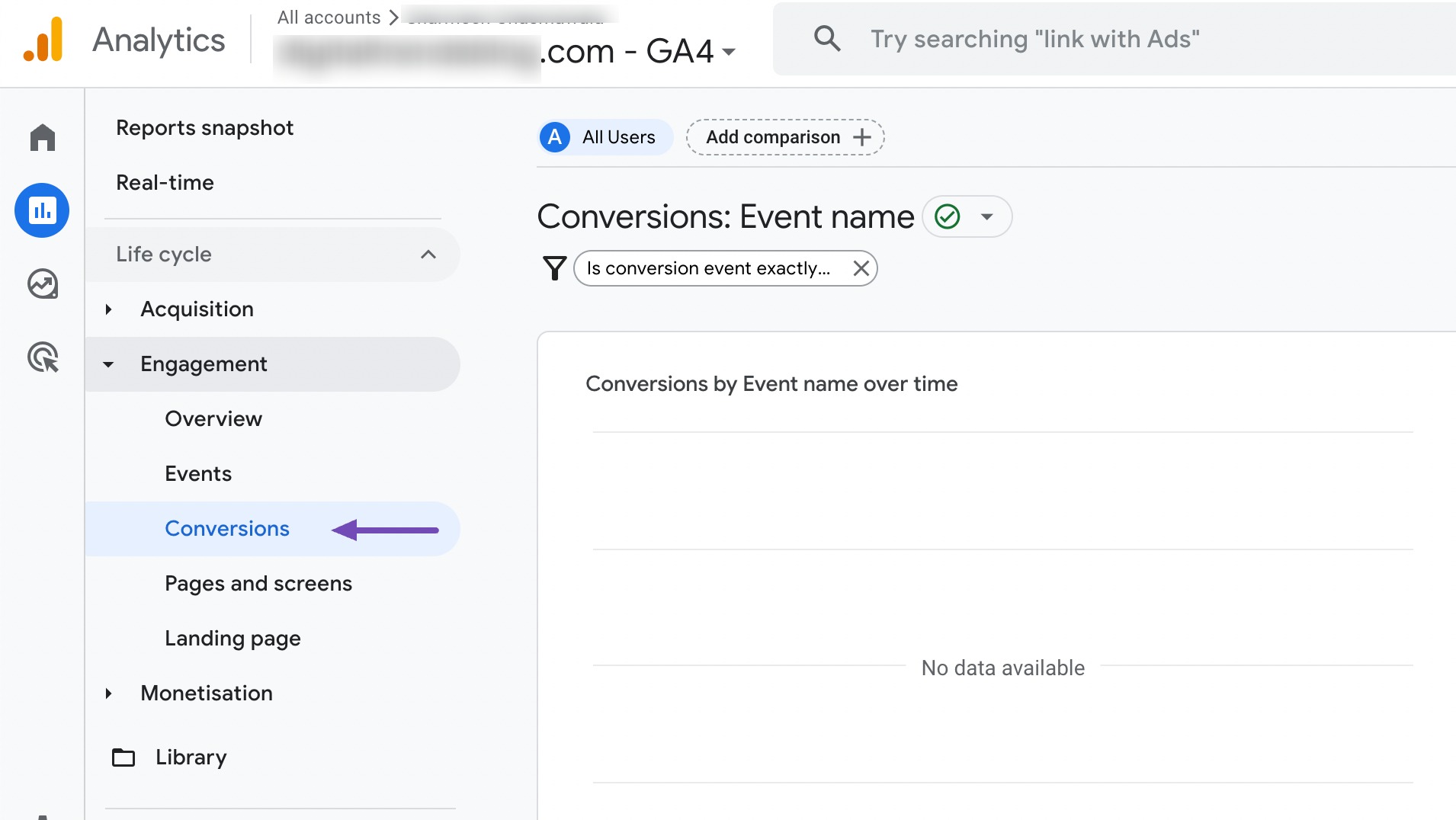
You can regularly review and analyze data to identify trends, opportunities, and areas for improvement in SEO strategies.
Not only this, but you can also take advantage of advanced features like custom segments, event tracking, and multi-channel funnels for deeper insights into audience interactions and conversions.
2 Google Search Console
Google Search Console, formerly known as Google Webmaster Tools, is a free SEO reporting tool provided by Google. It allows you to monitor and manage the site’s presence in Google Search results.
Google Search Console provides valuable insights into how Google perceives a website, identifies potential issues affecting its visibility in search results, and offers tools to optimize its performance.
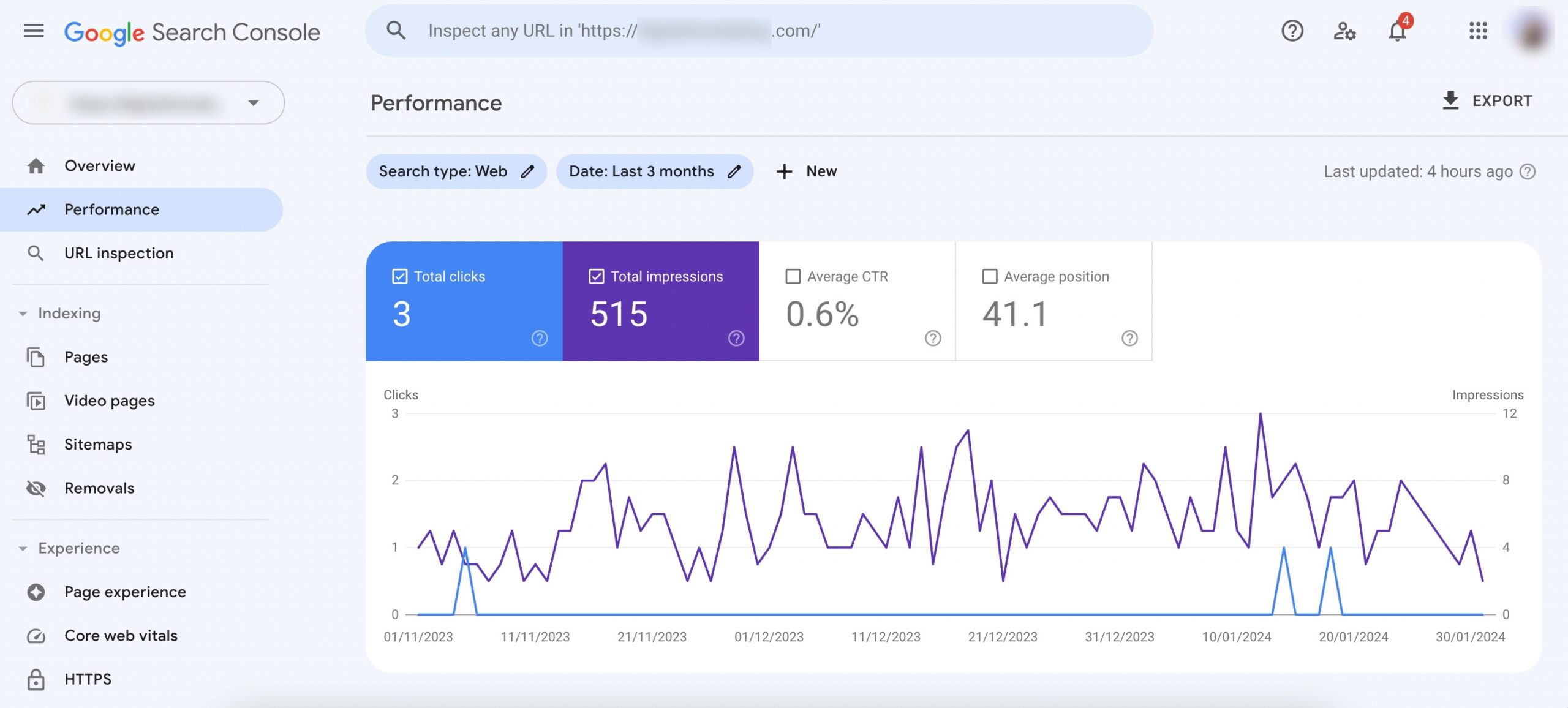
Monitoring Website Performance on Google Search Results
Google Search Console enables monitoring of various aspects of the website’s performance using Google search results. This includes:
- Checking the number of clicks, impressions, and average position for specific queries.
- Monitoring the indexing status of individual web pages and ensuring that Google can crawl and index the site effectively.
- Reviewing the number of pages indexed by Google and identifying any crawl errors or indexing issues.
- If applicable, monitor the performance of rich snippets, such as structured data markup and featured snippets.
Enhancing Website Visibility and SEO with Google Search Console
Google Search Console offers several features to enhance website visibility and improve SEO.
It also helps to find new keyword opportunities.

You can submit XML sitemaps to ensure that Google can discover and index all relevant pages on the website.

You can request the removal of outdated or irrelevant content from Google’s index.
Also, it is easy to identify and resolve crawl errors, such as broken links or server errors, that may hinder Google’s ability to crawl and index the site.
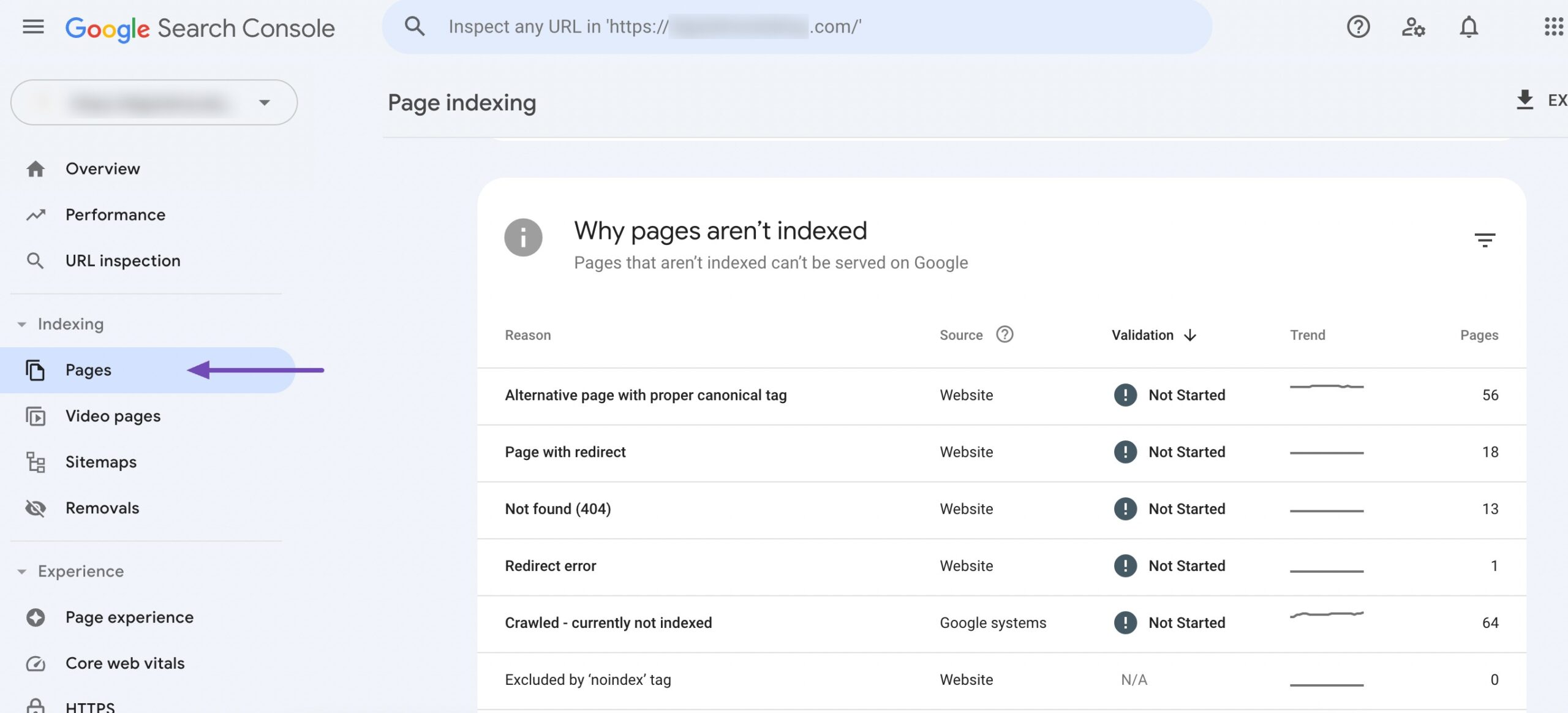
Tips for Using Google Search Console Effectively
Regularly monitor the performance and health of the website using the various reports available in Google Search Console.
Set up email notifications for important alerts, such as manual actions or indexing issues. For most SEO reporting, Google Search Console (GSC) clicks data is exported into a spreadsheet and then transformed into a chart to visualize year-over-year performance.
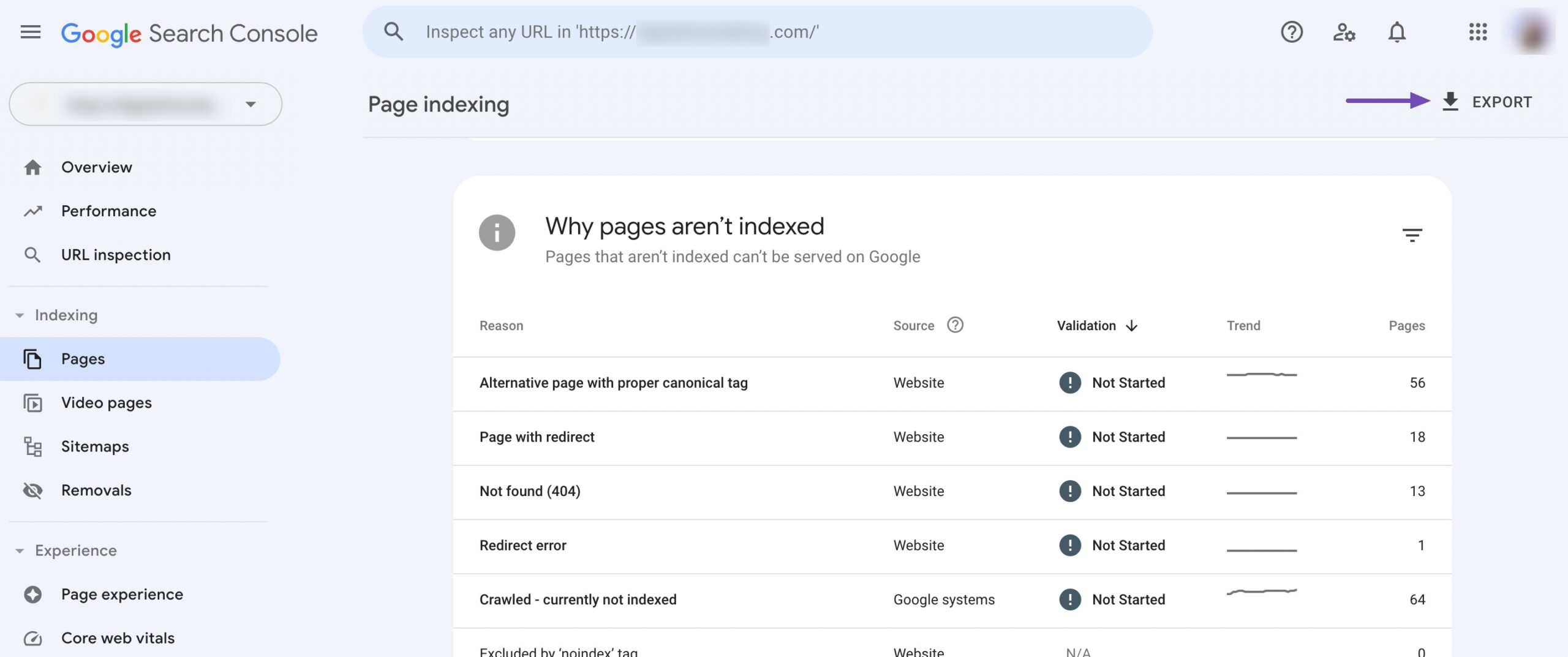
Use the URL Inspection tool to troubleshoot specific pages and ensure they are indexed properly.
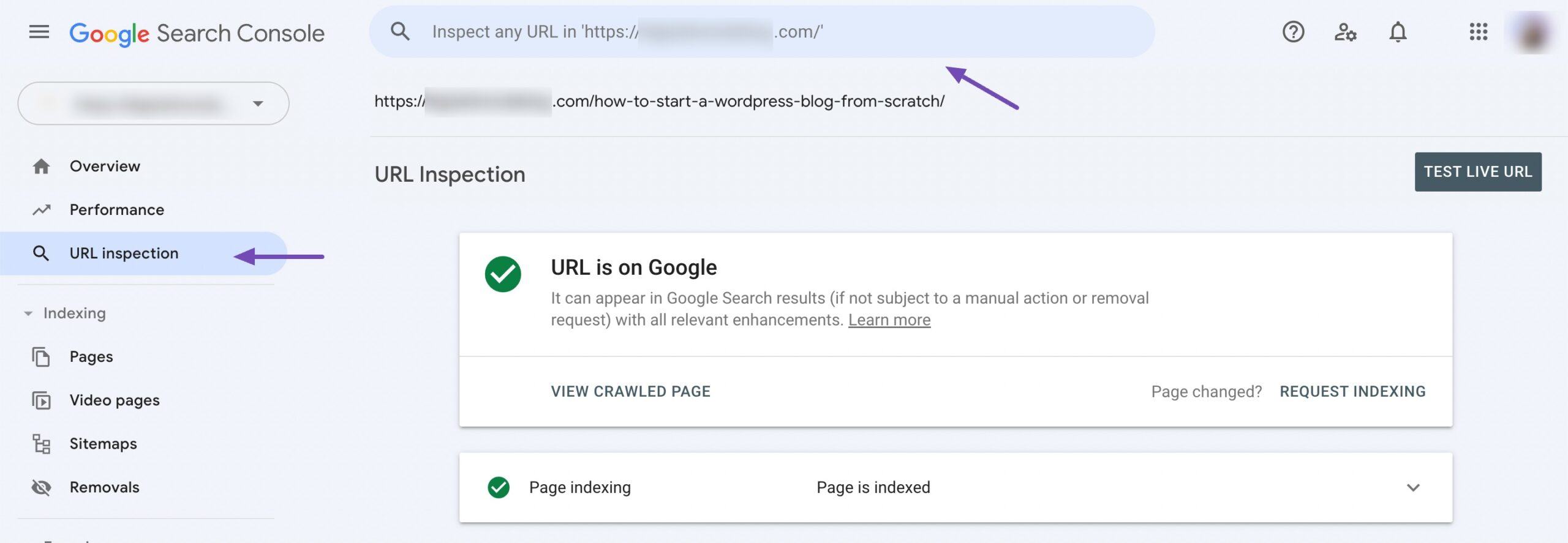
Continuously optimize the website based on the data and recommendations provided by Google Search Console to improve its visibility and performance in Google search results.
3 Google Trends
Google Trends is a powerful tool for SEO reporting. It provides insights into search trends and helps users understand the popularity of specific search terms over time.

Overview of Features
Google Trends offers a variety of features to help businesses understand search trends and optimize their SEO efforts.
With Search Volume Trends, you can track the popularity of search terms over time, allowing them to identify trends, seasonal patterns, and changes in user behavior.
The tool also offers Related queries and topics, allowing you to discover related keywords and trending topics to incorporate into your content strategy.
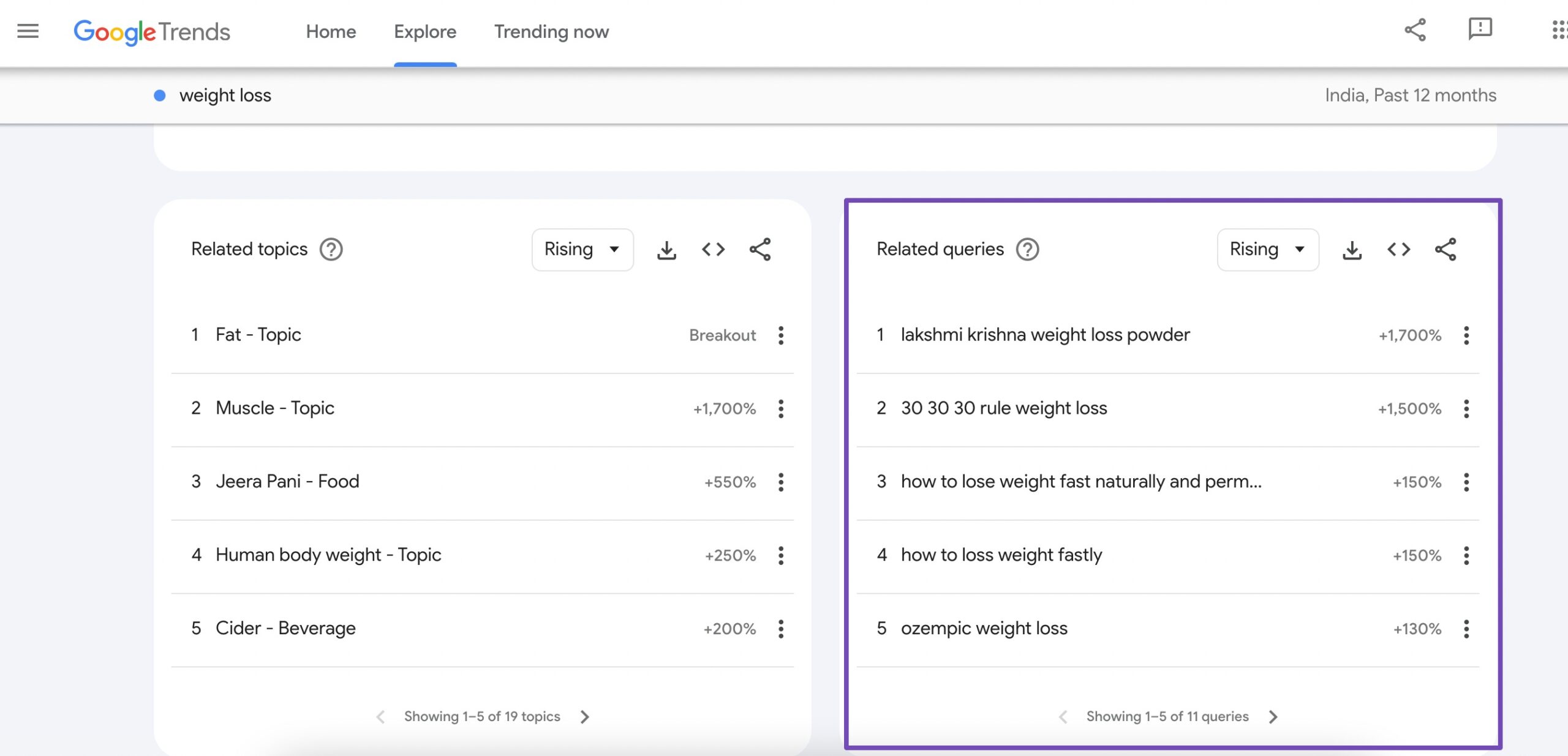
Comparative Analysis enables the comparison of the search interest of multiple terms or topics, facilitating competitive analysis and identification of strengths and weaknesses in SEO strategies.
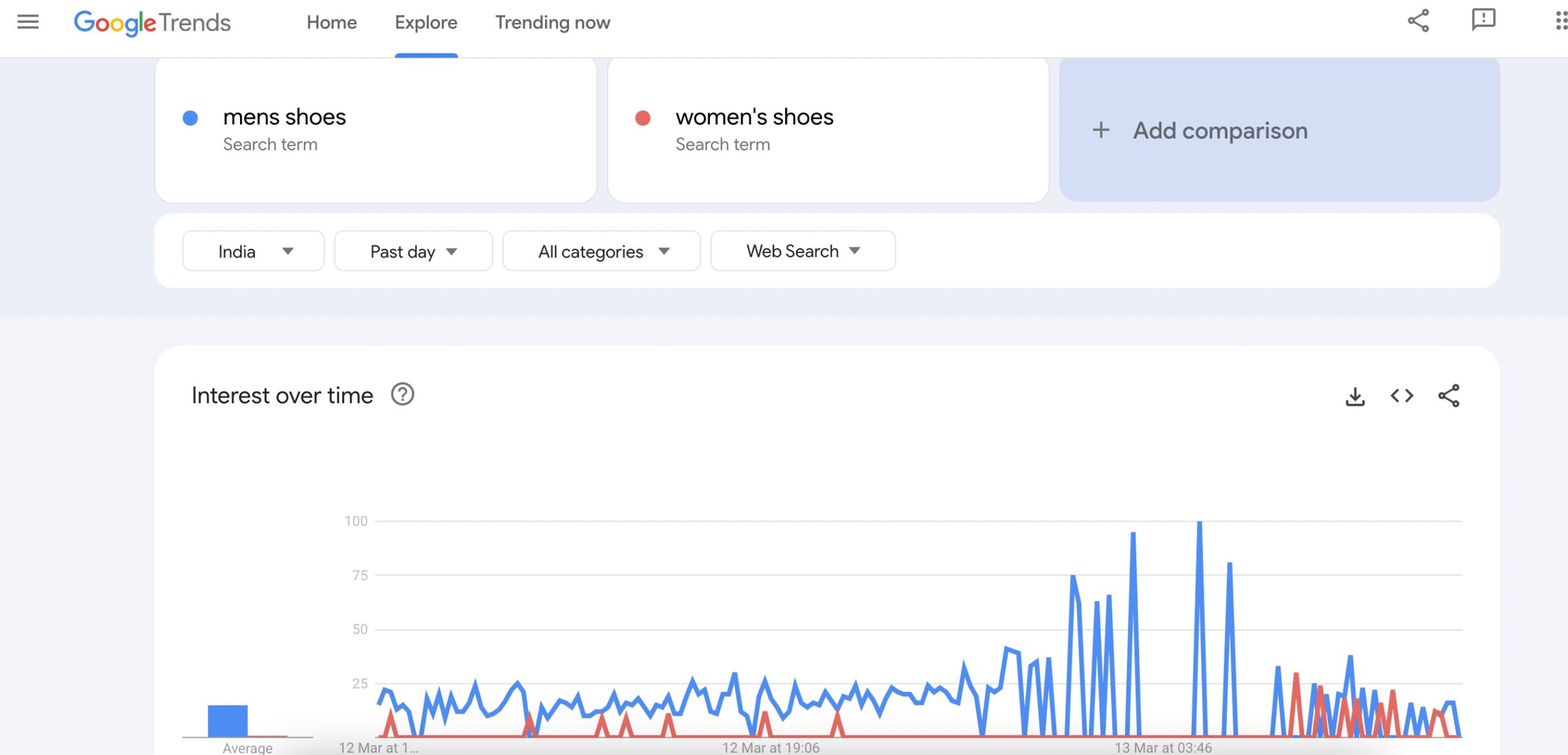
Tips for Using Google Trends Effectively
Identify seasonal trends by analyzing historical data and adjusting content accordingly to capitalize on peak interest periods.
Optimize local SEO by understanding regional interest and targeting specific geographic areas where the audience is most active.
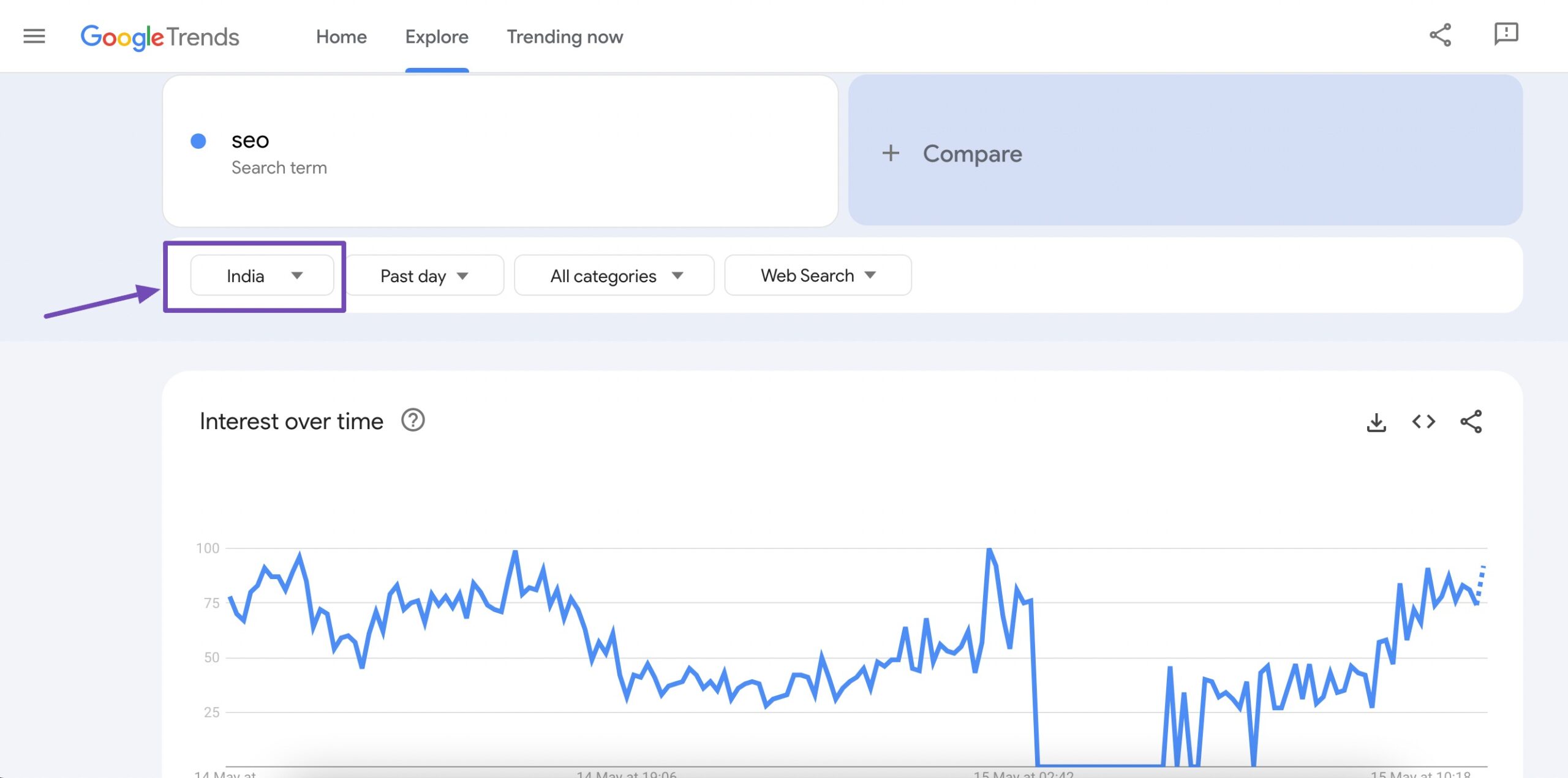
Keep an eye on trending topics in real-time data to create timely, engaging content for your audience.
4 Google Looker Studio
Google Looker Studio is a data visualization and business intelligence tool that allows the creation of customized reports and dashboards. This further helps to analyze and visualize data from various sources, including Google Analytics, Google Ads, and other marketing platforms.
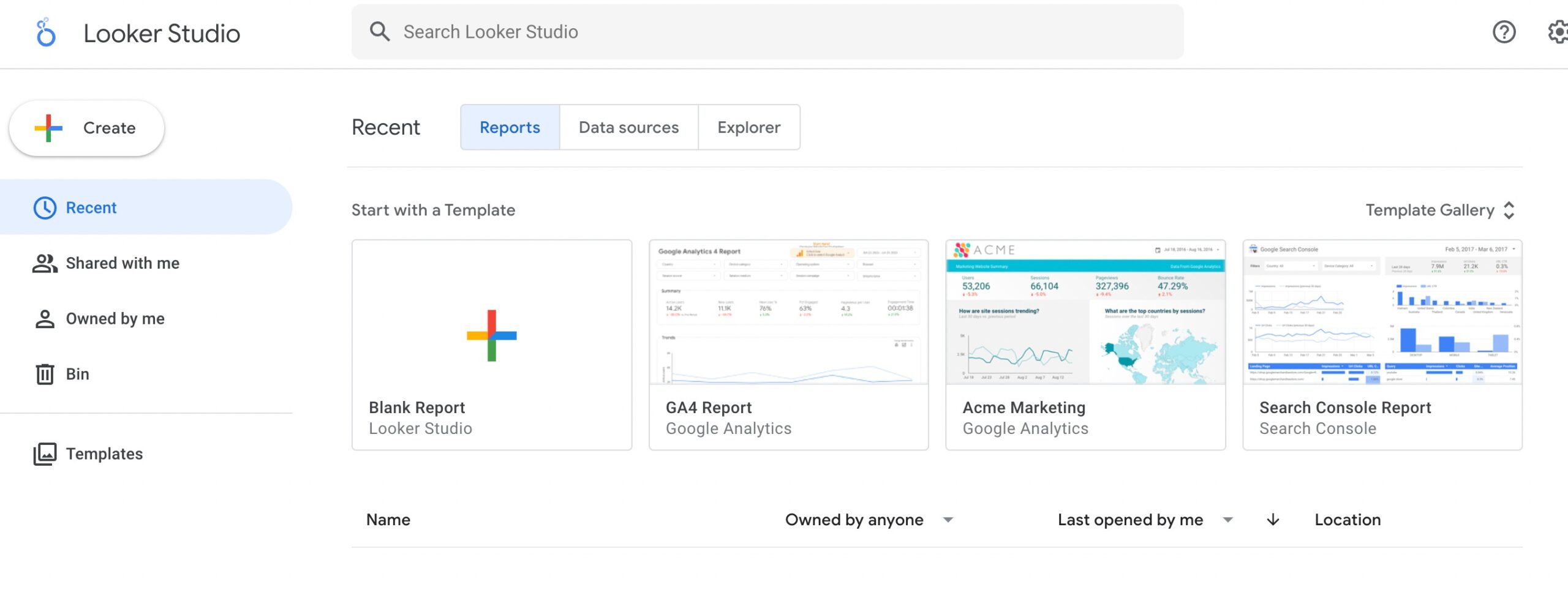
Overview of Features
Google Looker Studio offers:
- Customized Dashboards: Create tailored reports with data from multiple sources.
- Integration with Google Services: Access and analyze data from Google Analytics, Ads, and more within Looker.
- Advanced Analytics: Predictive modeling, cohort analysis, and segmentation for deeper insights.
- Collaboration and Sharing: Share reports, collaborate on analysis, and make data-driven decisions as a team.
- Data Security and Governance: Role-based access control and governance tools ensure data security and compliance.
Tips for Using Google Looker Studio Effectively
Before creating reports and dashboards, define clear objectives and KPIs that align with your SEO goals. This will help you focus on the most relevant metrics and ensure your reports provide actionable insights.
Integrate data from various sources, including Google Analytics, Google Search Console, and other SEO tools, to view your website’s performance comprehensively.
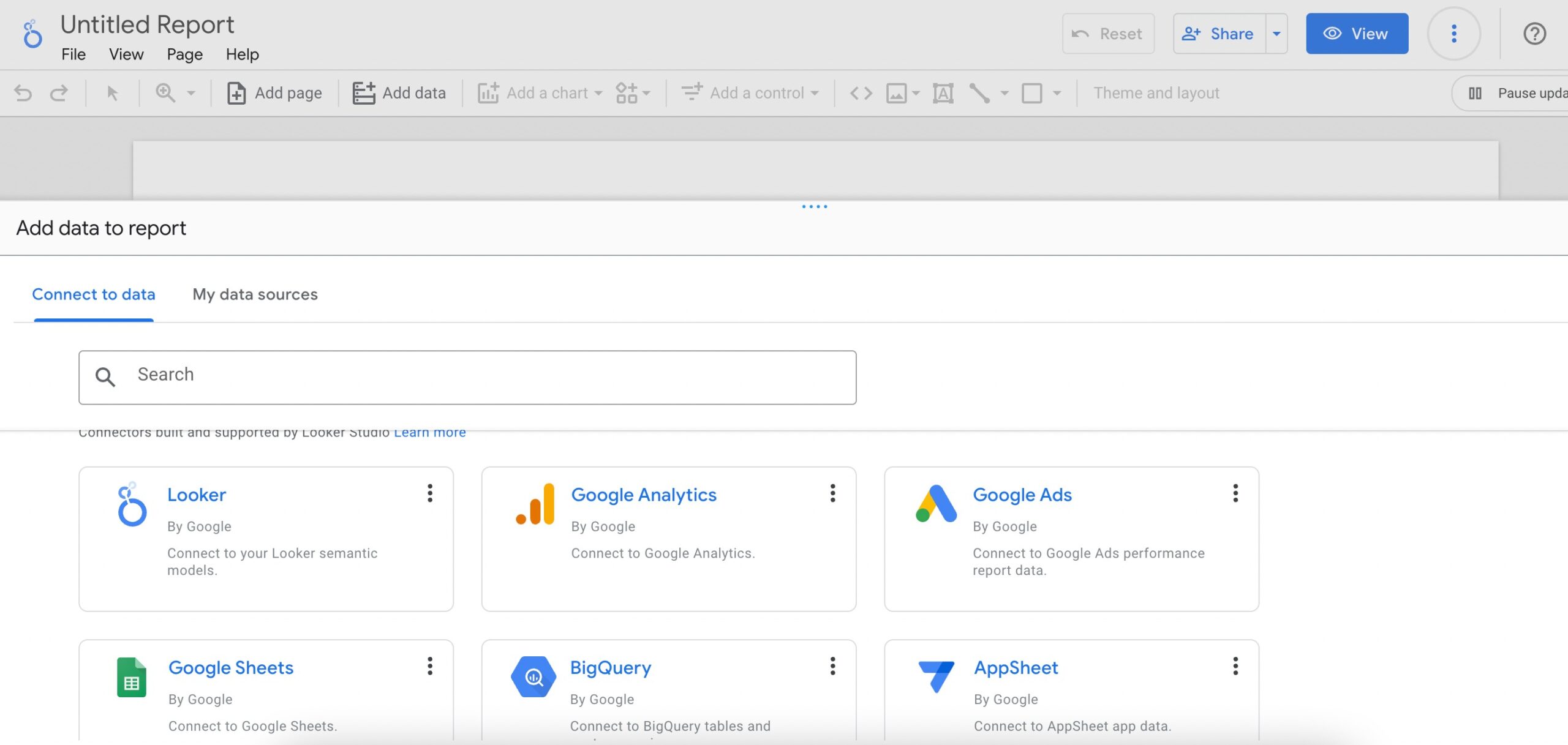
Use visualizations like line charts, bar graphs, and heatmaps to visualize key SEO metrics such as organic traffic, keyword rankings, and backlink profiles.
5 Rank Math Analytics
Rank Math is a comprehensive WordPress SEO plugin with powerful analytics features. It enables you to track and report on various aspects of your website’s SEO performance.
Overview of Features
- Integration with Google Services: Rank Math Analytics integrates with Google Search Console and Google Analytics, pulling data directly from these platforms into the WordPress dashboard.
- Keyword Tracking: You can monitor keyword rankings, impressions, clicks, and average positions. This helps in understanding how well the site is performing for targeted keywords.
- Site Analytics: Site Analytics give you an overview of your website’s content performance.
- Performance Overview: The analytics feature provides a comprehensive overview of metrics like total search traffic, total search impressions, total ranking keywords, CTR, and average position.
How to Use Rank Math Analytics for SEO Reporting
To set up Rank Math Analytics, connect it to the Google Search Console and Google Analytics account. Here’s what the analytics dashboard looks like:
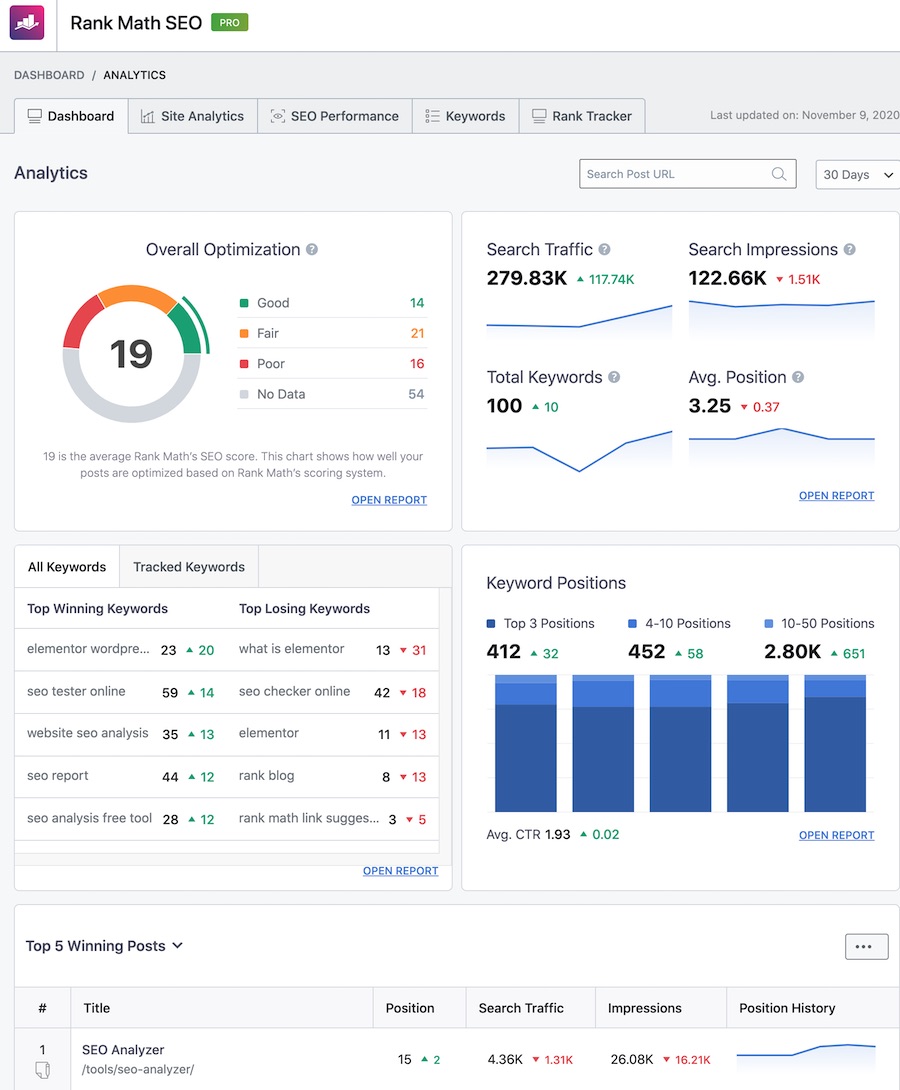
Rank Math offers suggestions on optimizing your posts based on the focus keywords you provide, helping you maximize their potential for organic traffic.
To give you a quick overview of your optimization efforts, Rank Math assigns each post an optimization score. For more detailed information, check out our guide on achieving a perfect score of 100/100 with Rank Math.
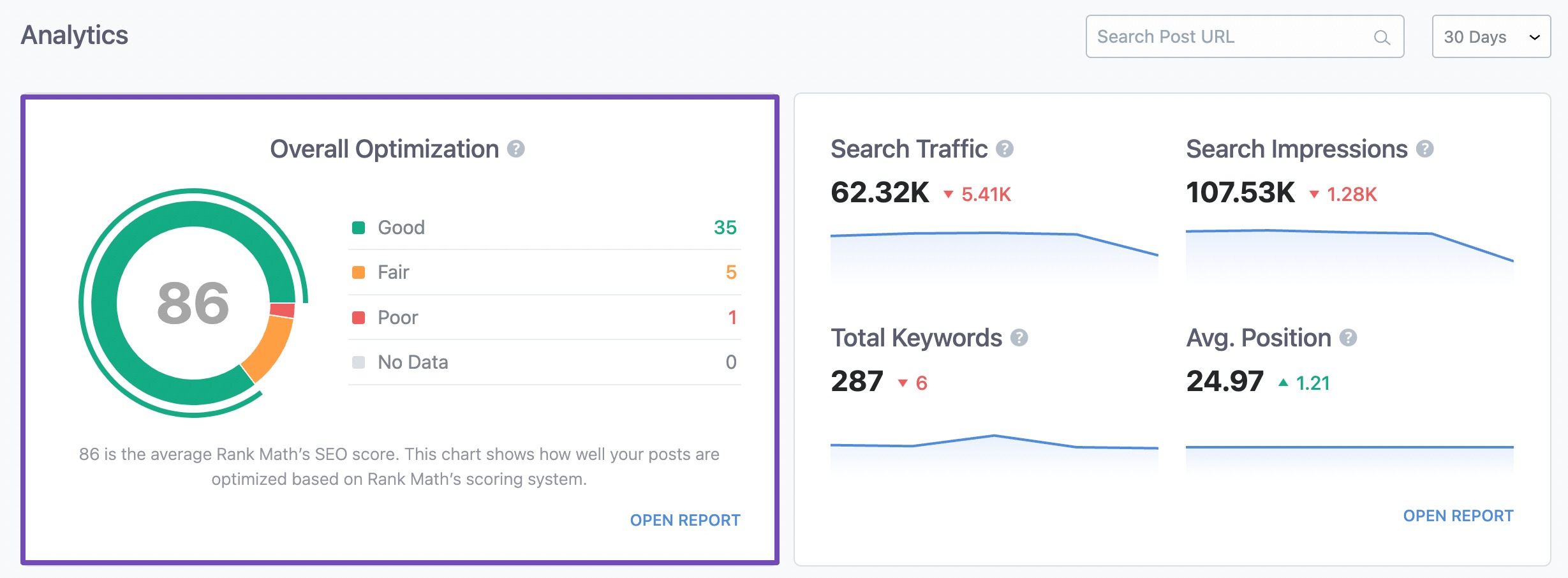
The Site Analytics feature provides an overview of how well or poorly the content across your website is performing.
For each post, you will see the post title, URL, SEO score, selected Schema type via Rank Math, internal and external link counts, traffic received within the selected timeframe, and the impressions in search results.
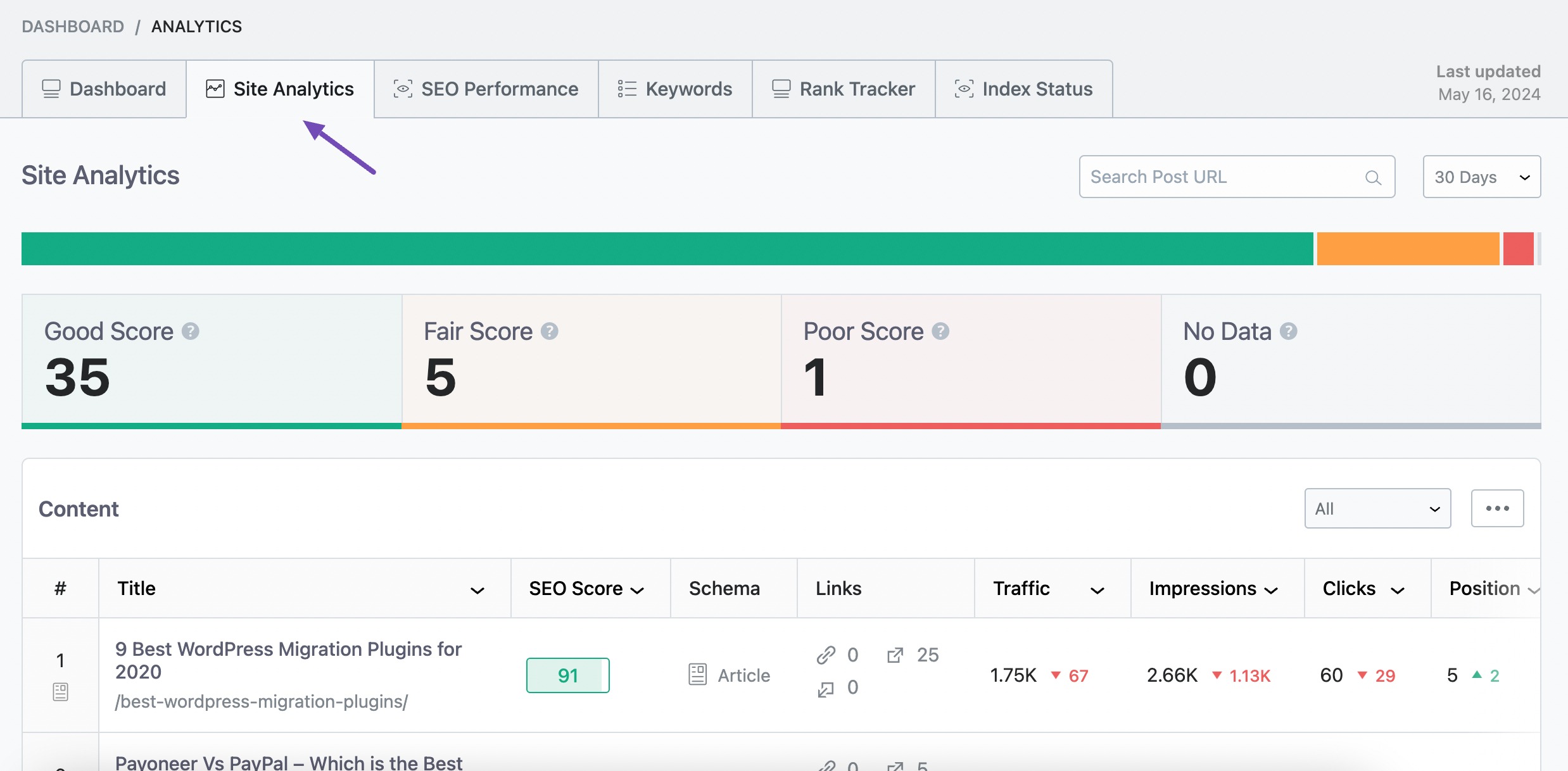
An SEO Performance report can help you track the overall website’s performance. The report includes metrics such as search traffic, search impressions, total keywords, search clicks, click-through rates (CTR), and average search positions.
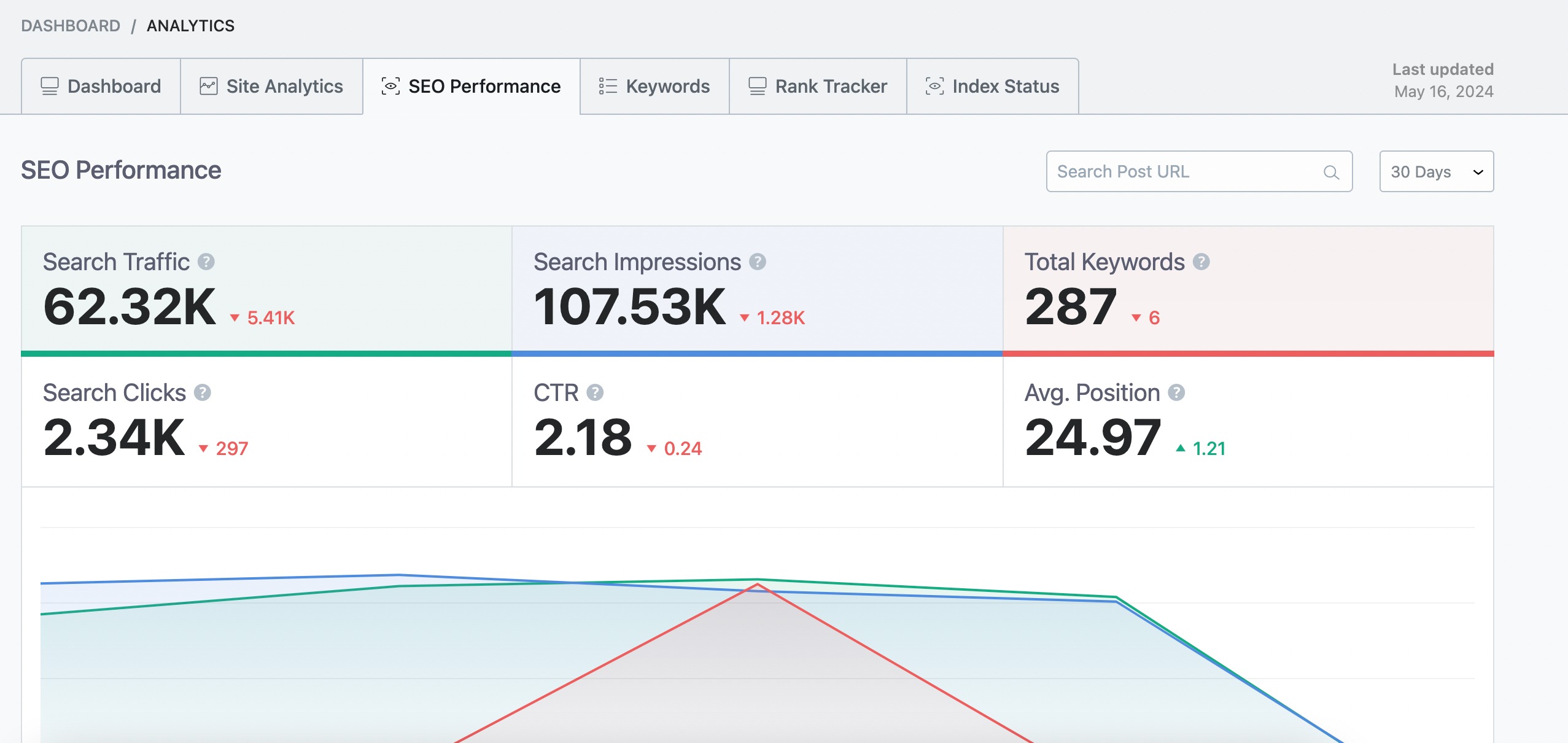
The keyword tracking feature allows you to monitor the performance of your target keywords. You can track top winning and losing keywords, keyword positions, and metrics such as rankings, impressions, and clicks over time.
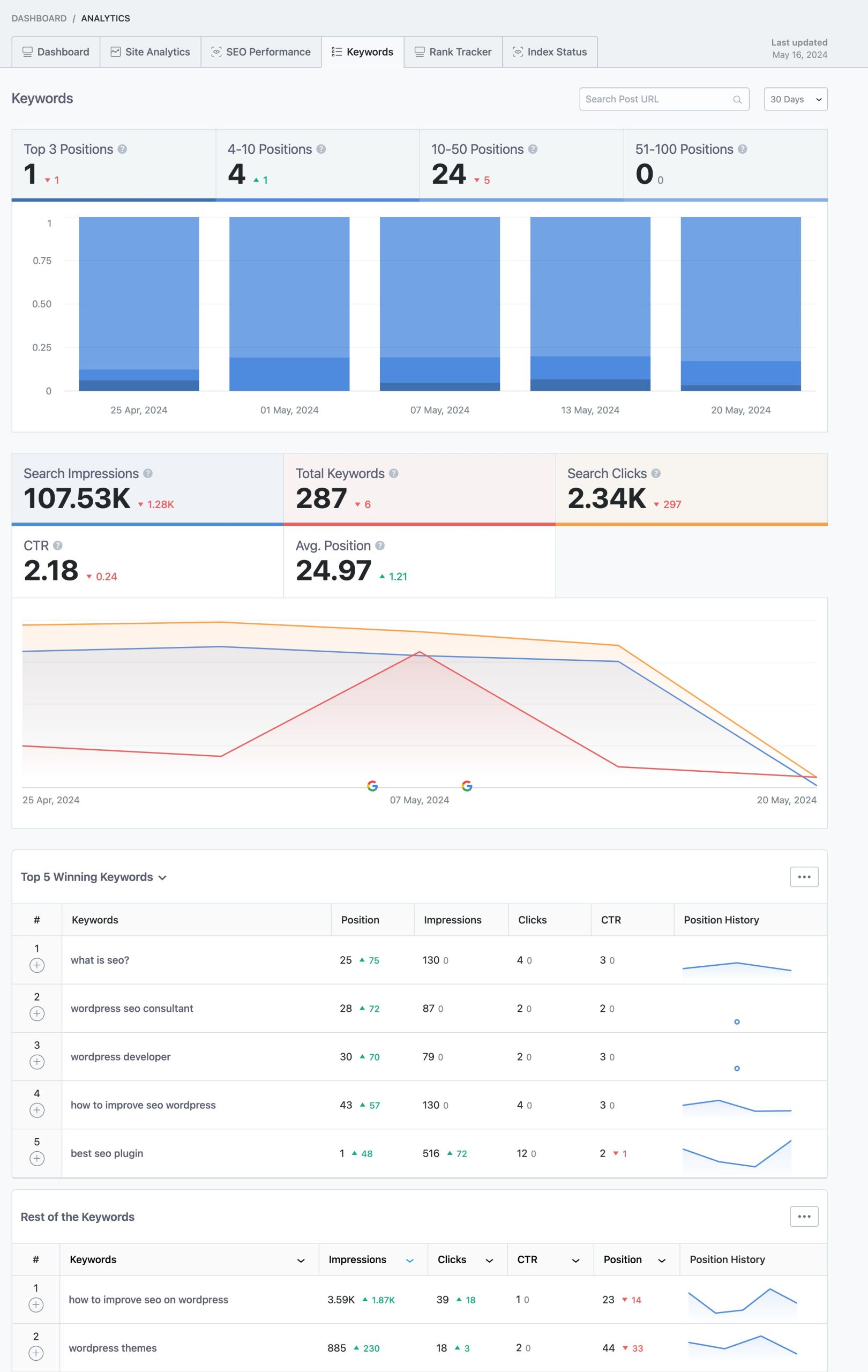
Rank Tracker is a PRO feature that helps you track the performance of your selected keywords. You enter the keywords in the Rank Tracker, and the plugin monitors and records their performance so you know which keywords work better for you.
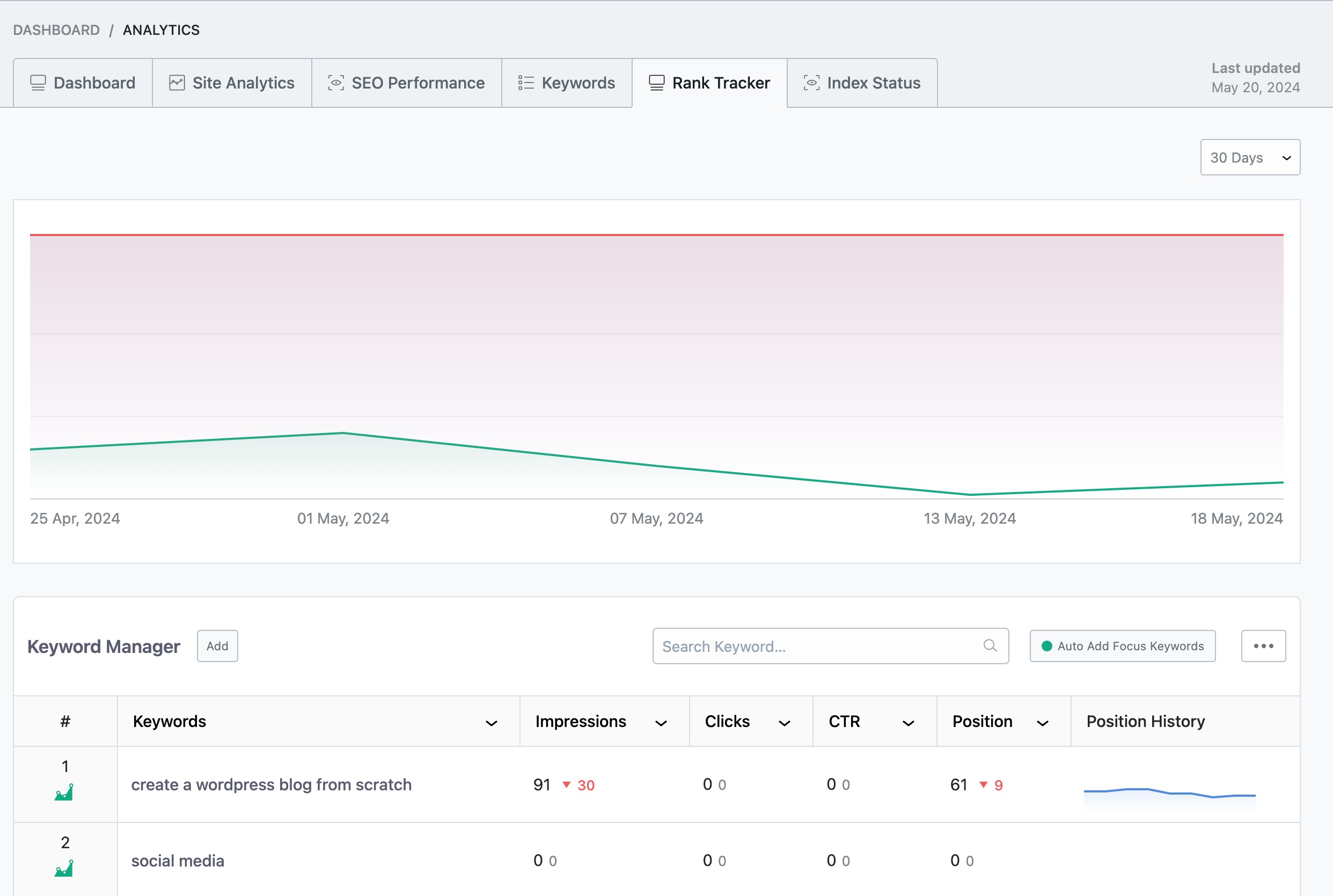
The Index Status tab lets you check the index status of your pages, posts, and custom post types (CPTs), giving you an overview of your site’s presence on Google.
To access the Index Status tab, ensure you have configured Rank Math to fetch this information by navigating to Rank Math SEO → General Settings → Analytics and enabling the Index Status tab.
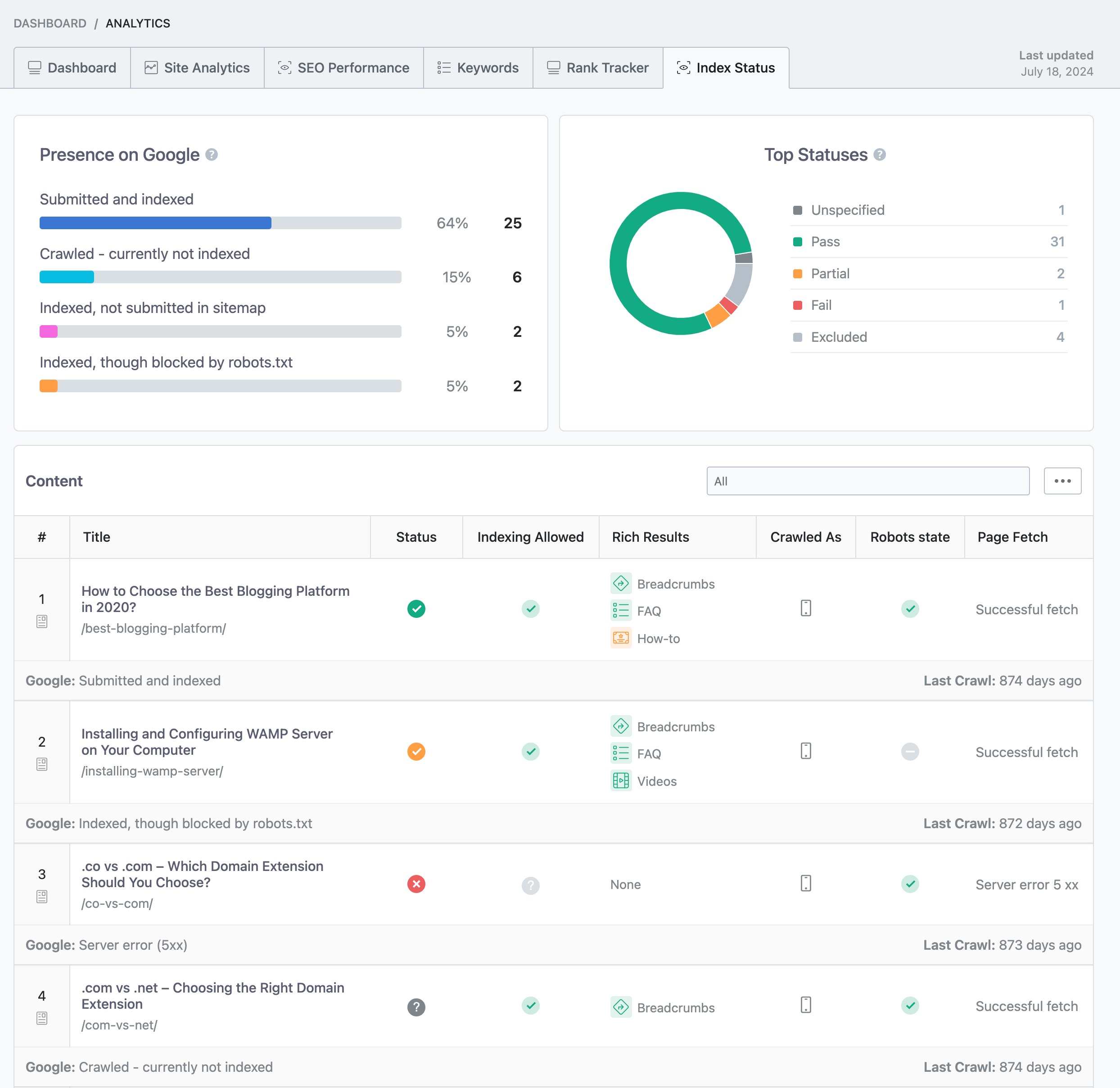
Refer to our dedicated tutorial on Rank Math Analytics to make the most out of this module.
Benefits of Using Rank Math Analytics for SEO Reporting
- Comprehensive Data Integration: The integration with Google Search Console and Google Analytics ensures that all relevant data is accessible from one dashboard, streamlining the SEO reporting process.
- User-Friendly Interface: The simple interface makes navigating and understanding the data easy, even without advanced technical knowledge.
- Actionable Recommendations: Rank Math offers actionable recommendations to improve SEO performance, making it easier to implement changes based on the insights gathered.
6 Ahrefs Free Tools
Ahrefs offers a suite of free tools that are invaluable for SEO reporting. These tools provide comprehensive insights into various aspects of a website’s performance, helping to assess the SEO strategies and make informed decisions.
Free Tools
We’ve listed below the free tools provided by Ahrefs.
- Free keyword rank checker: Report your site’s ranking position in any country.
- Free website traffic checker: Analyze your competitors’ website traffic.
- Free broken link checker: Identify and report on broken links.
- Free website authority checker: Assess any website’s Domain Rating (DR).
- Free keyword difficulty checker: Identify new keyword opportunities for your content.
Tips for Using Ahrefs Tools Effectively for SEO Reporting
Incorporate data from Site Explorer, Keywords Explorer, and Content Explorer into SEO reports to track website performance, keyword rankings, and content engagement.
Use Site Audit findings to identify and fix technical issues that may be impacting SEO performance and include recommendations in SEO reports for ongoing optimization.
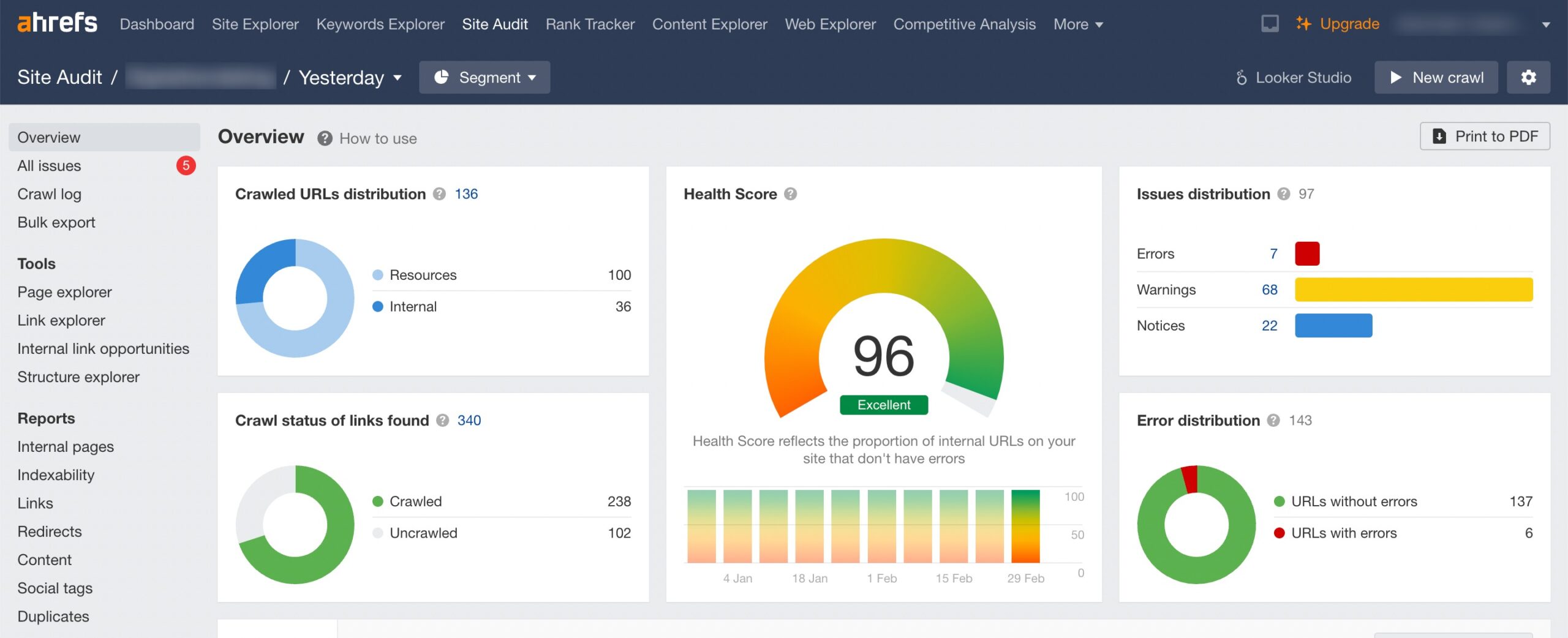
Utilize the SEO Toolbar to analyze competitors’ websites and benchmark against industry standards, providing valuable insights for SEO strategy development.
7 Screaming Frog
Screaming Frog SEO Spider is a website crawler that allows you to analyze and audit the websites for SEO issues. While it is primarily used for technical SEO audits, Screaming Frog can also be utilized as an effective SEO reporting tool.
Overview of Features
Screaming Frog SEO Spider offers a range of features that are essential for SEO reporting:
- Website Crawling: The tool crawls websites and provides detailed insights into technical aspects such as broken links, redirects, meta tags, and canonical tags.
- Data Export: Screaming Frog allows the export of crawl data into various formats, including CSV, Excel, and Google Sheets. This makes it easy to manipulate and analyze the data for SEO reporting purposes.
- Customizable Reports: You can generate customizable reports based on specific metrics and data points relevant to their SEO goals. This includes metrics such as page titles, meta descriptions, H1 tags, and more.
Tips for Using Screaming Frog Effectively
To use Screaming Frog as an SEO reporting tool, prioritize the most important SEO metrics for your reporting purposes.
Concentrate on elements such as meta tags, headings, internal and external links, indexability, and technical issues like 404 errors and redirect chains.
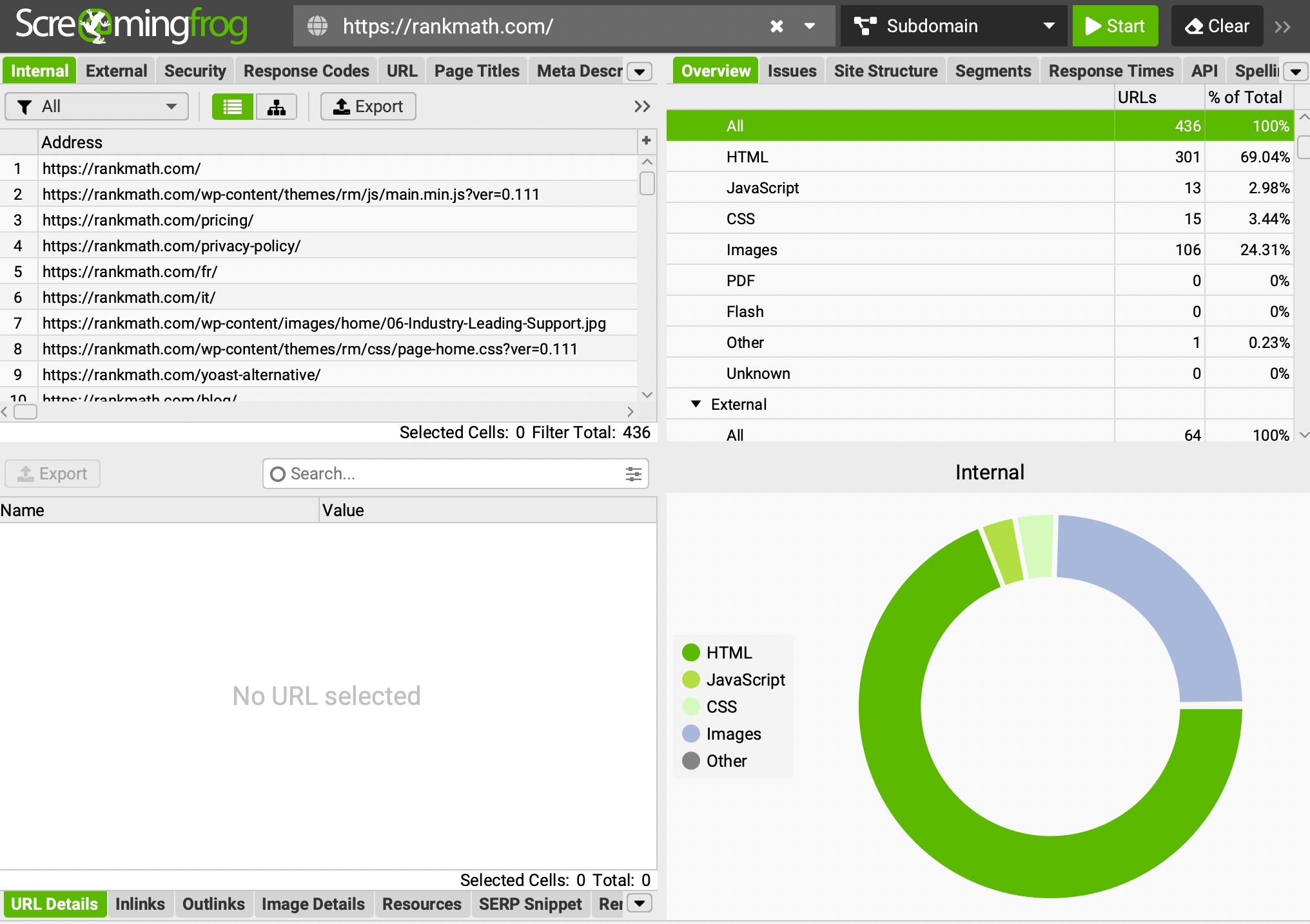
Use Screaming Frog’s filtering and segmentation features to focus on specific sections of your website or particular types of issues. This allows for a more targeted analysis and more actionable insights in your reports.
Export crawl data into Excel, CSV, or Google Sheets format for further analysis and manipulation. Use tools like Excel’s pivot tables and charts to visualize trends and identify patterns in the data.
4 Conclusion
Using free SEO reporting tools is essential for understanding and optimizing website performance in search engine results.
From tracking keyword rankings to analyzing backlink profiles and technical issues, these SEO reporting tools offer valuable insights that enable you to make informed decisions and improve online visibility.
Whether it’s Google Analytics for traffic analysis, Google Search Console for monitoring website performance, or Ahrefs for comprehensive SEO audits, numerous options are available to suit various needs and preferences.
By utilizing these SEO reporting tools effectively and incorporating their insights into actionable strategies, you can enhance the SEO efforts, and, attract more organic traffic.
If you like this post, let us know by Tweeting @rankmathseo.
